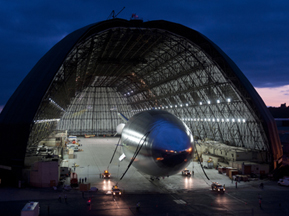

BNI teamed with Lockheed Martin to work on an unmanned, lighter-than-air vehicle that will maintain a geostationary position at an altitude of 65,000 feet. The vehicle, known as a High Altitude Airship (HAA), is being built by Lockheed Martin and is being funded by the Missile Defense Agency. Specifically, Barber-Nichols designed and produced the transonic fans that control the vehicle’s internal pressure and cause it to descend. To operate properly at altitude, the fan blade’s tip speed moves in excess of 333 m/s (1,100 ft/s). As gas accelerates through the fan’s converging and diverging blades, it reaches a relative supersonic speed. CFD Analysis drove the fan’s blade design and the sonic barrier was crossed at a point that minimized shock losses.


